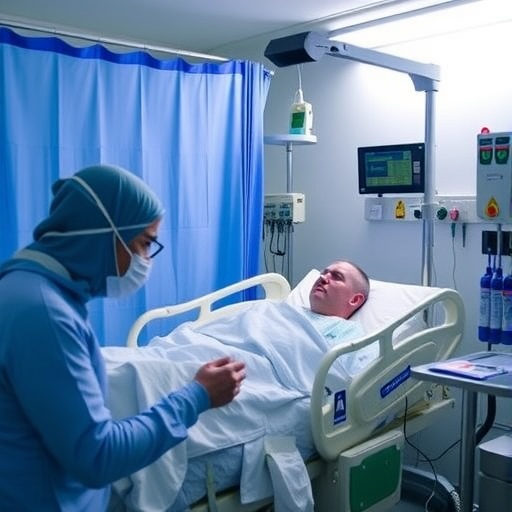A groundbreaking international investigation spearheaded by the University of Colorado Cancer Center has illuminated critical reasons behind the uneven effectiveness of a widely administered therapeutic regimen for acute myeloid leukemia (AML). This novel insight stands to revolutionize how oncologists tailor treatments, enhancing precision medicine approaches and ultimately improving patient prognoses in this aggressive hematologic malignancy.
Published in the esteemed journal Blood Cancer Discovery, this large-scale study represents the most comprehensive exploration to date focusing on patients receiving combination therapy involving venetoclax and hypomethylating agents (HMAs). By analyzing clinical and molecular data drawn from 678 AML patients, the research team has delineated how specific genetic aberrations in tandem with the developmental state of AML cells collaboratively dictate treatment responsiveness, unraveling complexities previously obscured in standard therapeutic paradigms.
Venetoclax, a potent inhibitor of the anti-apoptotic protein BCL-2, has emerged as a frontline therapeutic agent when combined with HMAs for newly diagnosed AML cases, especially in older adults with poor tolerance for intensive chemotherapy. Despite its promising clinical benefits and improved survival rates, a significant subset of patients exhibits primary resistance or experience disease relapse, hinting at underlying biological heterogeneity that impacts drug efficacy but remained poorly understood until now.
Dr. Daniel Pollyea, professor of medicine at the CU School of Medicine and lead investigator, emphasizes that the clinical heterogeneity seen in AML response patterns stems not only from genetic mutations but also from the cellular differentiation status of the leukemia. “Our study reveals that patient responses are tightly linked to both the mutational landscape and the maturation stage of leukemia cells present at diagnosis,” Pollyea explains. This dual-factor model provides a more robust framework for risk stratification than previous mutation-centric approaches.
Critically, the team uncovered that patients with monocytic AML subtypes—characterized by more differentiated leukemic cells—demonstrated markedly poorer outcomes when lacking the favorable NPM1 mutation. These patients were also enriched for additional mutations such as KRAS, a gene frequently implicated in oncogenic signaling and chemoresistance. This constellation of molecular features underscores a distinct biological subset of AML with innate resistance pathways, challenging conventional treatment regimens.
Such findings carry profound clinical implications because they shed light on the ‘escape mechanisms’ leukemic cells deploy to circumvent venetoclax action. The maturation state of monocytic cells appears to enable alternative survival signaling routes, which effectively neutralize the drug’s pro-apoptotic intent. By integrating mutational profiling with cell differentiation markers, clinicians can now better predict which patients harbor such resistant clones and may require alternative or adjunctive therapies.
Historically, AML treatment strategies emphasized genetic abnormalities or cellular phenotypes independently, but this study’s integrative analysis approach reveals a synergistic effect, offering a more nuanced comprehension of therapeutic resistance. “It’s akin to unveiling a back door that cancer cells exploit to dodge treatment,” notes Pollyea, highlighting the potential to develop novel agents or combination therapies designed to block these alternative pathways and improve remission durability.
This research not only refines prognostic models but also heralds a tangible shift toward personalized medicine in AML. Utilizing comprehensive molecular and phenotypic data at the point of diagnosis, healthcare providers can now better tailor therapeutic regimens to individual patients’ disease biology, enhancing the likelihood of response and reducing unnecessary exposure to ineffective treatments.
Further collaborative efforts are underway to enlarge the patient dataset and validate the predictive power of this combined model in prospective clinical trials. Pollyea and his colleagues envision forthcoming studies that will employ this knowledge to dynamically guide treatment decisions in real time, potentially transforming therapeutic outcomes in AML—a historically challenging and lethal cancer.
Institutions worldwide contributed to this collaborative effort, including the Knight Cancer Institute at Oregon Health and Science University, multiple French cancer centers such as Hôpital Lyon Sud and CHU Clermont-Ferrand, as well as the Lineberger Comprehensive Cancer Center at the University of North Carolina. Their collective expertise and pooled data resources were instrumental in identifying subtle yet critical biological distinctions within AML patient populations.
The University of Colorado Anschutz Medical Campus, home to the Cancer Center and a nexus of innovative research, continues to cement its role at the vanguard of hematological oncology advances. With robust funding exceeding $900 million annually, including public and philanthropic sources, the campus supports pioneering research endeavors aimed at confronting cancers like AML through cutting-edge science and multidisciplinary collaboration.
This study’s revelations mark an important step forward in decoding the biological variability that governs AML treatment success and failure, fostering hope for more effective, targeted interventions. As Dr. Pollyea articulates, approaching leukemia treatment with nuanced molecular precision not only improves individual patient journey but also pushes the entire field closer to enduring cures for this devastating disease.
Subject of Research: Acute Myeloid Leukemia (AML) treatment response variability based on genetic mutations and leukemia cell maturity.
Article Title: Understanding the Biological Drivers of Venetoclax Resistance in AML: Integrative Insights into Genetic and Cellular Determinants
News Publication Date: June 2024
Web References:
University of Colorado Cancer Center: https://medschool.cuanschutz.edu/colorado-cancer-center
Blood Cancer Discovery article: https://aacrjournals.org/bloodcancerdiscov/article/doi/10.1158/2643-3230.BCD-24-0256
Keywords: Acute Myeloid Leukemia, Venetoclax, Hypomethylating Agents, AML Treatment Resistance, NPM1 Mutation, KRAS Mutation, Cancer Cell Differentiation, Personalized Medicine, Hematologic Oncology, Genetic Biomarkers
Tags: acute myeloid leukemia treatment resistanceBCL-2 inhibitors in cancer therapybiological heterogeneity in leukemiaclinical outcomes in AML patientscombination therapy for leukemiagenetic aberrations in AMLimproving patient prognoses in AMLinternational research on leukemia treatmentsovercoming drug resistance in cancer treatmentprecision medicine in oncologytargeted therapies for hematologic malignanciesvenetoclax and hypomethylating agents





